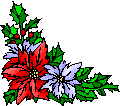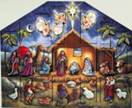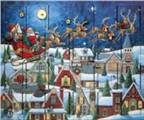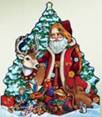Advent Calendars
History of the Advent CalendarToday, we use advent calendars to count down the days of Christmas. The calendars usually have 24 numbered doors that are opened each day beginning December 1st and ending on Christmas Eve. Behind each door can be a small surprise, bible verse, a bit of a story that continues each day, or a fun activity to perform. These calendars can be home made from paper, popsicle sticks, pictures, or any thing imaginable. Heirloom advent calendars made from wood can be passed down from one generation to the next.
Advent is the four-week period beginning on the Sunday nearest the feast day of St. Andrew the Apostle (November 30) through the following three Sundays. Historians estimate that Advent, which derives from the Latin word for coming, has been celebrated since the fourth century. The period originally began as a time for converts to Christianity to prepare for baptism, but is now more commonly associated with the anticipation of the anniversary of Christ’s birth on December 25.
Today advent calendars count down the days till Christmas. Most have 24 days, but there are calendars that count down the last 12 days of Christmas. The origin of the Advent Calendar can be traced back to the 19th Century, when German Protestants made chalk marks on doors or lit candles to count the days leading up to Christmas. The first known Advent Calendar, which was made by hand, is from the year 1851.
Other early styles were the Advent clock or the Advent candle - a candle for each of the 24 days until Christmas, similar to today’s Advent wreath. In religious families little pictures were hung up on the wall - one for each day in December. Another tradition was to paint chalk strokes on the door, one per day until Christmas Eve.
Gerhard Lang (1881-1974) from Maulbronn, Germany is widely considered the producer of the first printed Advent calendar in the early 1900s. When he was a child his mother made him an advent calendar with 24 little candies affixed to a piece of cardboard.
Later, Lang began working in the printing office of Reichhold & Lang. He produced little colored pictures which could be affixed to a piece of cardboard each day in December. This was the first printed Advent Calendar without windows to open, published in 1908. This Calendar was named "Christmas Calendar" or "Munich Christmas Calendar". At the beginning of the 20th Century Lang produced the first Advent Calendars with little doors to open.
Lang had produced about 30 different advent calendars when he was forced to close his company due to World War II. Cardboard was rationed and companies were forbidden to produce calendars with pictures. Richard Sellmer began producing the advent calendars we know today at the end of the war.
Dwight D. Eisenhower is often credited for the popularity of the Advent calendar tradition in the United States. During his presidency, Eisenhower was photographed opening an Advent calendar with his grandchildren and the photo ran in several national newspapers.
Homemade Advent Calendars Advent calendars can be as simple or elaborate as you want to make them. Homemade advent calendars also gives you the chance to make a new one each year or improve upon the one you made the previous year. Following are some simple ideas that are inexpensive to make, so you can enjoy a full month of Christmas.
Ribbon Chain Advent Calendar
- Simply cut out 24 strips of construction paper in the color of your choice. Number one side of the strip and write a fun activity on the other side. Decorate with drawings, stickers, beads, etc. Glue the ends together, remembering to loop them together. Each day, remove one of the chains and enjoy a fun activity.
Popsicle Stick Advent Calendar - Number 24 different popsicle sticks and write the activity on the other side of the stick. Decorate anyway you would like with paint, markers, beads, etc. Place the sticks in a container of your choice. You can even use a thoroughly washed tin can. Wrap the outside of the can in fabric, ribbon, construction paper, etc. Each day remove a stick and have fun. Tree Branch Advent Calendar - Hang a small tree branch on a wall. Cut out 24 circles and number each one and write an activity on the other side. Decorate the circles in way you wish. Punch a hole in the top and tie a piece of yarn to the circle and tie the other end to the tree branch. Vary the lengths of the yarn, so that the circles are hung at different levels. Remove a decorated circle each day for a fun activity.Note:
you can cut any shapes you want to hang on the branch. Stars look really nice too. Muffin Pan Advent Calendar - Use the large muffin pan that has 24 holes. Place an activity in each hole or mix it up by adding a surprise or piece of candy in various holes. Cut out circles from construction paper, wrapping paper, or use white paper decorated to your liking. Number each circle and use double sided tape to attach each circle to the muffin pan hole.Christmas Card Advent Calendar- Cut the front off of 24 old Christmas cards. Write a fun activity on the back of each card. String a cord or piece of ribbon across the wall and hang each card on the cord with a clothes pin.
An advent calendar can be made out of just about anything. You can always just number 24 pieces of paper, write an activity on one side, fold it over and number the paper. Drop the pieces of paper in any receptacle you have on hand. You can use a basket, bowl, pail, a shoebox covered in pretty paper, etc.
Advent Calendar Activities

|

|

|
- 1 cup all purpose flour
- 1/2 cup salt
- 2 tsp. cream of tartar
- 1 tbsp. ground cinnamon
- 2 tsp. ground ginger
- 1 tsp. ground nutmeg
- 1 tsp. ground cloves
- 2 tbsp. vegetable oil
- 1 cup water

|







